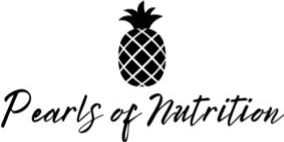
Garlic is without a doubt my [Pearl] go-to cooking addition. The more garlic the better, breath be dammed #lifeofasingledietitian. Ha. I think part of the reason I love garlic so much, beyond it’s tantalizing aroma and the fact that butter and garlic will bring about world peace, is that there is some science behind cooking garlic and how to achieve the best flavor.
Garlic is the bulb of the Allium sativum plant. The purpose of bulbs is to store food for the plant during times of dormancy. It’s one of the easiest plants to grow. You literally just put cloves in the ground in the fall and then pull up whole bulbs in the spring. How cool is that?! Not only that, but once you pull it up it will stay good in your pantry (or more traditionally by hanging) for up to 3 months. You can also store in the refrigerator or freezer for an even longer time. I don’t know about you, but I have a bowl full of garlic in my pantry. Did you ever wonder why it smells so strongly when cooking but you never notice it in your pantry?
That’s where the science comes in. Put on your glasses, we’re about to get nerdy. The amino acids in garlic (and onions) are kept in a different spot than the enzyme alliinase. When garlic is cut the cell walls are broken and allows the surfer-containing amino acids to react with alliinase to produce the compound allicin which is responsible for the flavor and small of garlic. The more cell walls you break the more flavor you will get which is why, in addition to ease of peeling, you crush garlic cloves before mincing them. If you allow crushed and chopped garlic to sit the allicin will intensify. Allicin is pretty unstable and begins to break down when you cook it so the flavor wont continue to grow. While too much of the garlic-y flavor may be overwhelming for your taste buds the allicin is the component that provides much of the health value of garlic so I recommend giving your garlic about 5 minutes of “rest” after chopping to allow for allicin production.
Why should you eat this allicin-filled food? Garlic helps to protect the lining of our blood vessels from the damage of free radicals and inflammation. This is SUPER important for your health, especially for individuals who have been diagnosed with diabetes, heart disease, atherosclerosis, or other inflammatory diseases. Other super-powers from garlic include lowering blood pressure, and anti-clotting, anti-bacterial, anti-viral, and anti-cancer properties.
What else does garlic have? NUTRITION! Garlic is a good source of selenium, a nutrient we covered in another Nerd Out for it’s role in anti-oxidant activity in the body. Don’t worry, there is more- vitamin C, B6, thiamin, calcium, iron, phosphorus, potassium, manganese, copper, zinc, magnesium, riboflavin, and pantothenic acid. Though we typically don’t eat enough garlic to get huge amounts of these nutrients every little bit counts! Plus, if something has all of these health-promoting properties AND tastes delicious it is a no-brainer.
Are you convinced now? Good. The garlic you choose in the store or the farmers market should be firm with skins that aren’t too overly dry. If you come across a rotted one or one that is sprouting you should avoid. While most people buy large batches of garlic and let it sit in their pantry, I recommend only purchasing what you will use for the week and making it one of those items you pick up each time you are at the farmers market or the grocery store. The fresher the food the more nourishing it is for your body.
What are your favorite recipes to use garlic in? Some of ours are:
Perfect Tailgating Chili
Jesus’ Tears Curried Chicken
Smoked Salmon Egg Frittata
Hot Italian Sausage and Acorn Squash Hash
We use garlic in probably half of the recipes in our fall ebook. Don’t have the ebook yet? Sign up for our email list here to get your FREE copy.
Xo
Pearl
